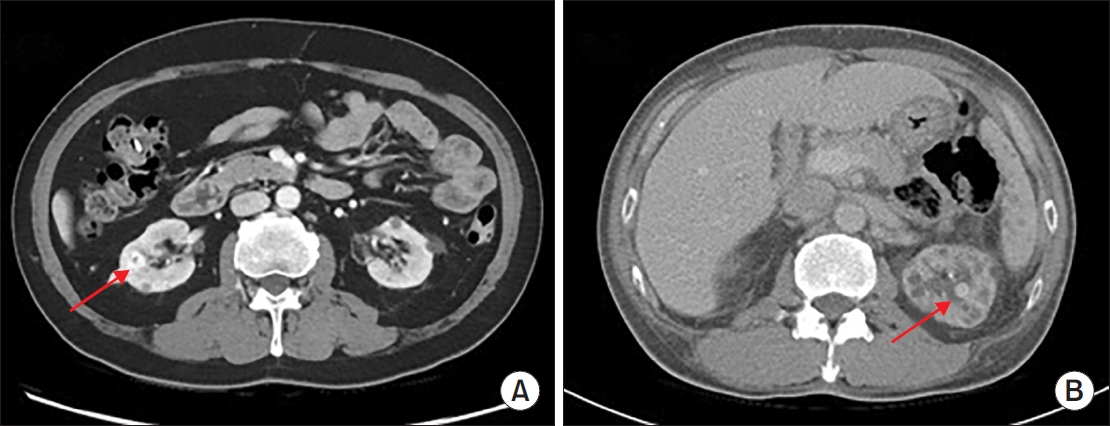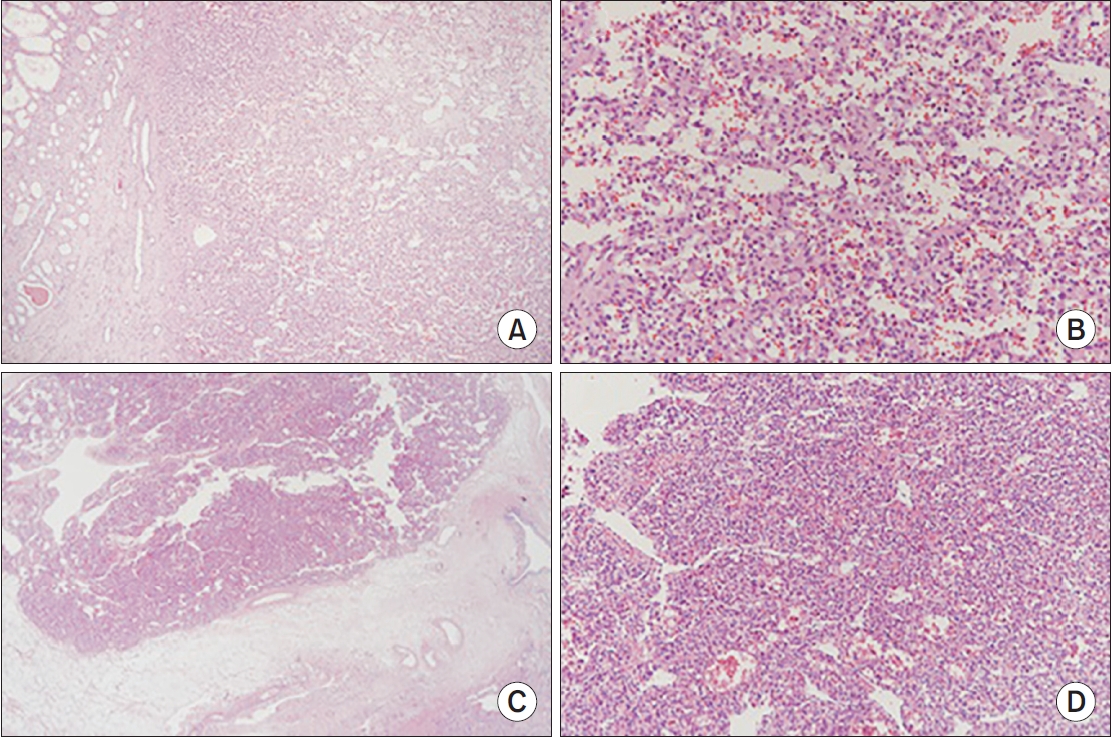Articles
- Page Path
- HOME > Urogenit Tract Infect > Volume 20(1); 2025 > Article
- Case Report Hemangioma Mistaken for Renal Cell Carcinoma in a Patient With End-Stage Renal Disease: A Case Report
-
Hyung-Lae Lee
 , Dong-Gi Lee
, Dong-Gi Lee , Jeong Woo Lee
, Jeong Woo Lee , Jeonghyouk Choi,
, Jeonghyouk Choi,
-
Urogenital Tract Infection 2025;20(1):48-51.
DOI: https://doi.org/10.14777/uti.2550008004
Published online: April 30, 2025
Department of Urology, College of Medicine, Kyung Hee University, Seoul, Korea
- Corresponding author: Jeonghyouk Choi Department of Urology, Kyung Hee University Hospital at Gangdong, College of Medicine, Kyung Hee University, 892 Dongnam-ro, Gangdong-gu, Seoul 05278, Korea Email: jhchoi0@gmail.com
Copyright © Korean Association of Urogenital Tract Infection and Inflammation
This is an open access article distributed under the terms of the Creative Commons Attribution Non-Commercial License (http://creativecommons.org/licenses/by-nc/4.0) which permits unrestricted non-commercial use, distribution, and reproduction in any medium, provided the original work is properly cited.
- 1,414 Views
- 17 Download
- 1 Crossref
Abstract
- Hemangiomas are rare, benign vascular neoplasms that are more common in patients with end-stage renal disease. Here, we describe 2 cases of hemangioma misdiagnosed as renal cell carcinoma before renal transplantation. The key finding in our case was the misdiagnosis of hemangiomas as renal cell carcinoma based on computed tomography and magnetic resonance imaging in patients with end-stage renal disease. Because living transplantation was planned for our patients, we performed rapid surgical resection of the heterogeneously enhancing renal masses to avoid delays in transplantation. Our case highlights the importance of rapid surgical resection of enhanced renal masses to confirm diagnosis, thereby avoiding delays in patients scheduled for renal transplantation.
HIGHLIGHTS
INTRODUCTION
CASE REPORT
DISCUSSION
-
Funding/Support
This study received no specific grant from any funding agency in the public, commercial, or not-for-profit sectors.
-
Research Ethics
This study was approved by the Institutional Review Board (IRB No. 2025-01-015). The patient provided informed consent for publication of this case.
-
Conflict of Interest
The authors have nothing to disclose.
-
Author Contribution
Conceptualization: JC; Data curation: JC; Formal analysis: JWL; Methodology: DGL; Project administration: HLL; Visualization: HLL; Writing - Original draft: HLL; Writing - review & editing: DGL, JWL.
NOTES


- 1. Kondo T, Sasa N, Yamada H, Takagi T, Iizuka J, Kobayashi H, et al. Acquired cystic disease-associated renal cell carcinoma is the most common subtype in long-term dialyzed patients: Central pathology results according to the 2016 WHO classification in a multi-institutional study. Pathol Int 2018;68:543-9.ArticlePubMedPDF
- 2. Aravind A, Ahuja S, Malik S, Zaheer S. Anastomosing hemangioma of the kidney: a rare case report. Int J Surg Case Rep 2025;126:110659.ArticlePubMedPMC
- 3. Abboudi H, Tschobotko B, Carr C, DasGupta R. Bilateral renal anastomosing hemangiomas: a tale of two kidneys. J Endourol Case Rep 2017;3:176-8.ArticlePubMedPMC
- 4. Kim CS, Choi SJN, Kim SS, Suh SH, Bae EH, Ma SK, et al. An anastomosing hemangioma mimicking a renal cell carcinoma in a kidney transplant recipient: a case report. BMC Nephrol 2021;22:262.ArticlePubMedPMCPDF
- 5. Gong C, Li J, Lv D, Ding M. Anastomosing hemangioma of the kidney: a case report. Asian J Surg 2024 Jul 24:S1015-9584(24)01525-2. doi: 10.1016/j.asjsur.2024.07.153. [Epub].ArticlePubMed
- 6. Campbell S, Pilmore H, Gracey D, Mulley W, Russell C, McTaggart S. KHA-CARI guideline: recipient assessment for transplantation. Nephrology (Carlton) 2013;18:455-62.PubMed
- 7. Kasiske BL, Cangro CB, Hariharan S, Hricik DE, Kerman RH, Roth D, et al. The evaluation of renal transplantation candidates: clinical practice guidelines. Am J Transplant 2001;1 Suppl 2:3-95.PubMed
- 8. Knoll G, Cockfield S, Blydt-Hansen T, Baran D, Kiberd B, Landsberg D, et al. Canadian Society of Transplantation: consensus guidelines on eligibility for kidney transplantation. CMAJ 2005;173:S1-25.ArticlePubMedPMC
- 9. Zhou J, Yang X, Zhou L, Zhao M, Wang C. Anastomosing hemangioma incidentally found in kidney or adrenal gland: study of 10 cases and review of literature. Urol J 2020;17:650-6.PubMed
- 10. Bunnapradist S, Danovitch GM. Evaluation of adult kidney transplant candidates. Am J Kidney Dis 2007;50:890-8.ArticlePubMed
- 11. MacLennan S, Imamura M, Lapitan MC, Omar MI, Lam TB; Hilvano-Cabungcal AM, et al. Systematic review of oncological outcomes following surgical management of localised renal cancer. Eur Urol 2012;61:972-93.ArticlePubMed
- 12. Ceccarelli G, Codacci Pisanelli M, Patriti A, Biancafarina A. Renal cavernous hemangioma: robot-assisted partial nephrectomy with selective warm ischemia. Case report and review of the literature. G Chir 2015;36:197-200.ArticlePubMedPMC
- 13. Perdiki M, Datseri G, Liapis G, Chondros N, Anastasiou I, Tzardi M, et al. Anastomosing hemangioma: report of two renal cases and analysis of the literature. Diagn Pathol 2017;12:14.ArticlePubMedPMCPDF
REFERENCES
Figure & Data
REFERENCES
Citations

- Editorial for UTI 2025 Vol. 20 No. 1 - Highlights of This Issue’s Papers and the UTI Editors’ Pick
Koo Han Yoo
Urogenital Tract Infection.2025; 20(1): 1. CrossRef



 KAUTII
KAUTII
 ePub Link
ePub Link Cite
Cite

